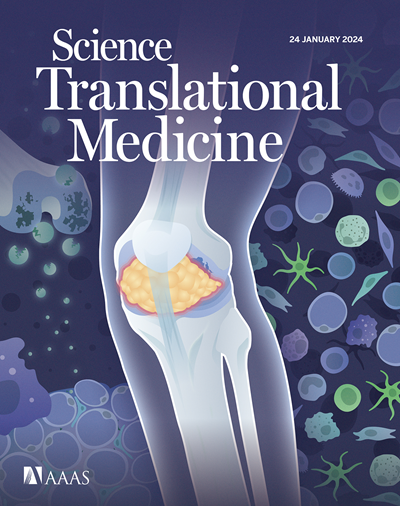通过瞬时抑制重要基因实现基因靶向肝细胞的体内扩增
IF 15.8
1区 医学
Q1 CELL BIOLOGY
引用次数: 0
摘要
基于同源定向修复(HDR)的基因组编辑是一种可以永久纠正多种遗传疾病的方法。然而,由于终末分化组织中的 DNA 修复机制效率低下且不精确,这种方法的实用性受到了限制。在这里,我们测试了 "修复驱动"(Repair Drive)技术,这是一种在成年小鼠体内选择性扩增 HDR 校正肝细胞的平台技术。修复驱动涉及通过敲除一个重要基因富马酸乙酰乙酸水解酶(Fah)来对肝脏进行瞬时调理,并通过治疗性转基因顺式传递该重要基因的非靶向版本。我们的研究表明,"修复驱动 "能将健康野生型小鼠中正确靶向肝细胞的比例提高到 25%,从而使治疗性转基因人因子 IX ( FIX ) 的表达量提高五倍。修复驱动程序的耐受性良好,在为期一年的随访中没有诱发毒性或肿瘤发生。这种方法可以扩大体细胞基因组编辑治疗肝脏疾病的范围。本文章由计算机程序翻译,如有差异,请以英文原文为准。
In vivo expansion of gene-targeted hepatocytes through transient inhibition of an essential gene
Homology-directed repair (HDR)–based genome editing is an approach that could permanently correct a broad range of genetic diseases. However, its utility is limited by inefficient and imprecise DNA repair mechanisms in terminally differentiated tissues. Here, we tested Repair Drive, a platform technology for selectively expanding HDR-corrected hepatocytes in adult mice in vivo. Repair Drive involves transient conditioning of the liver by knocking down an essential gene, fumarylacetoacetate hydrolase ( Fah ), and delivering an untargetable version of the essential gene in cis with a therapeutic transgene. We show that Repair Drive increased the percentage of correctly targeted hepatocytes in healthy wild-type mice up to 25%, which resulted in a fivefold increased expression of a therapeutic transgene, human factor IX ( FIX ). Repair Drive was well tolerated and did not induce toxicity or tumorigenesis during a 1-year follow-up. This approach may broaden the range of liver diseases that can be treated with somatic genome editing.
求助全文
通过发布文献求助,成功后即可免费获取论文全文。
去求助
来源期刊

Science Translational Medicine
CELL BIOLOGY-MEDICINE, RESEARCH & EXPERIMENTAL
CiteScore
26.70
自引率
1.20%
发文量
309
审稿时长
1.7 months
期刊介绍:
Science Translational Medicine is an online journal that focuses on publishing research at the intersection of science, engineering, and medicine. The goal of the journal is to promote human health by providing a platform for researchers from various disciplines to communicate their latest advancements in biomedical, translational, and clinical research.
The journal aims to address the slow translation of scientific knowledge into effective treatments and health measures. It publishes articles that fill the knowledge gaps between preclinical research and medical applications, with a focus on accelerating the translation of knowledge into new ways of preventing, diagnosing, and treating human diseases.
The scope of Science Translational Medicine includes various areas such as cardiovascular disease, immunology/vaccines, metabolism/diabetes/obesity, neuroscience/neurology/psychiatry, cancer, infectious diseases, policy, behavior, bioengineering, chemical genomics/drug discovery, imaging, applied physical sciences, medical nanotechnology, drug delivery, biomarkers, gene therapy/regenerative medicine, toxicology and pharmacokinetics, data mining, cell culture, animal and human studies, medical informatics, and other interdisciplinary approaches to medicine.
The target audience of the journal includes researchers and management in academia, government, and the biotechnology and pharmaceutical industries. It is also relevant to physician scientists, regulators, policy makers, investors, business developers, and funding agencies.
 求助内容:
求助内容: 应助结果提醒方式:
应助结果提醒方式:


